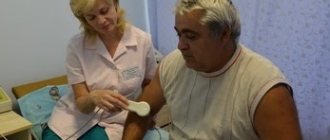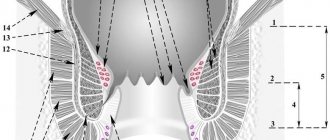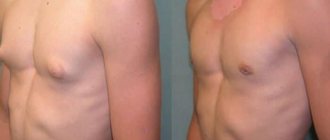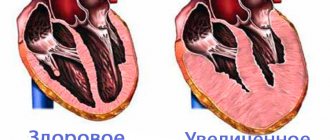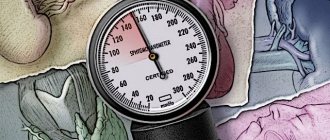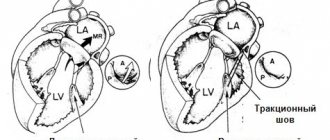Author:
- Agapov Mikhail Andreevich Head of the surgical department, surgeon, oncologist, coloproctologist
4.5 (Votes: 3)
The best methods for treating diseases are ways to quickly, effectively and painlessly get rid of the problem. The use of laser vaporization of hemorrhoids (hemorrhoids) is just such a method, the “gold standard” in treatment.
If a patient has been diagnosed with grade 1, 2, 3 hemorrhoids, laser vaporization of hemorrhoids becomes one of the best ways to eliminate the problem. Not all clinics can use this method. Like due to the lack of equipment (high-quality medical lasers cost hundreds of thousands of rubles, consumables for them are expensive). This is also due to the lack of skills by specialists in using a medical laser. Our department has the best multifunctional lasers and the most experienced surgeons who perform such operations every day.
Doctors of the University Clinic of Moscow State University. M.V. Lomonosov at work
The laser vaporization technique has its own contraindications: stage 4 of the disease, very large nodes cannot be correctly treated using this particular method. There are other methods to cure these advanced forms of the disease. They also use a laser, but using a different technology (laser coagulation).
How is the operation performed?
The doctor prepares the necessary documents. The nurse leads you into the room, you change into disposable clothes and after 5 minutes you go to the operating room. There the doctor gives you anesthesia, similar to that used for dental treatment (filtration). Anesthesia is not needed for this operation; it is more difficult to tolerate than the operation itself. After anesthesia, the skin over the nodes is pierced with a light guide and the veins of the hemorrhoidal plexuses are destroyed with laser radiation. All.
The patient is taken to a short-stay ward. After 40-60 minutes he goes home (or on business, if necessary).
Price of the procedure
When performing laser operations on internal hemorrhoidal plexuses (internal hemorrhoids), they first ensure that the blood supply to the node is stopped by suturing the vessels or coagulating them. The terminal branches of the superior rectal artery, located 2-3 m from the dentate line, are visualized using a proctoscope, sutured or coagulated. In this case, it is necessary to provide additional anesthesia to the patient. Therefore, the cost of laser vaporization of hemorrhoids for internal hemorrhoids will be slightly higher, since the presence of an anesthesiologist and the use of additional pharmacological drugs are necessary.
Also, the price of laser vaporization of hemorrhoids will depend on the number and size of nodes, the condition of the tissues around the pathological focus, the presence of concomitant diseases in the patient, his general condition and the need for additional research, equipment and consumables.
The cost of the procedure can be found in the “Prices” section of our website.
How does the rehabilitation process occur after laser removal of hemorrhoids?
After the operation, the doctor prescribes maintenance treatment to speed up recovery. If your work is not heavy, for example, in the office, then you can go to work an hour after the operation. But I personally am against such extreme behavior. It's better to feel sorry for your butt and stay at home for a day.
Caring for your butt mainly comes down to hygiene. Medicines are secondary, although they speed up the recovery process.
It is advisable to see a doctor 5-8 days after surgery to assess the healing process.
If the patient had small hemorrhoids and nothing bothers him after the operation, there is no need to come for control. For large hemorrhoids, another examination is sometimes required after 10-15 days.
Advantages of laser vaporization of hemorrhoids
- There is no pain during or after the procedure;
- Minimum blood loss when removing nodes;
- The minimum time for the procedure is about 15 minutes;
- Aesthetics of the postoperative area already in the early stages after the procedure;
- “Lifting” effect of tissues after exposure to a laser beam - the skin and mucous membrane are tightened, the appearance of the perianal area is significantly improved;
- Fast healing without large, rough scars;
- No stitches required;
- Minimally invasive procedure - used on an outpatient basis, without hospitalization.
Laser vaporization (evaporation of tissue at the site of laser beam exposure) is a well-proven method in many areas of medicine associated with low-traumatic surgery. It has been used in gynecology, cosmetology, and phlebology for decades. The effect is associated with the pinpoint impact of a laser beam. That is, a flow of high-power energy, extremely low dispersion, with a cross-section almost the thickness of a hair, is directed in a precise manner to certain areas of pathologically altered tissue. A targeted impact at the site of contact causes immediate evaporation of liquid from the tissue. As a result:
- some excess fluid is removed from the intercellular matrix and cells;
- swelling, compression of nerve fibers decreases and, as a result, pain decreases;
- a narrow beam of laser radiation allows the surgeon to work carefully, removing only what is unnecessary and without injuring healthy tissue areas - thereby achieving minimal trauma (low-invasiveness);
- Before exposure, the laser conductor is placed inside the hemorrhoidal node (hemorrhoids) itself and vaporization is carried out without destroying the mucous membrane or skin and nerve endings in them - therefore the postoperative period is practically not accompanied by pain, the need for pain relief is minimal
; - high-temperature effects on structures in the hemorrhoidal node cause the formation of connective tissue cords. A connective tissue frame appears in the walls of the node, creating a tightening effect - the same “lifting” effect
. The formation (connective tissue “framework”) that appears after laser vaporization of hemorrhoids takes on part of the functions of the destroyed ligamentous apparatus (ligaments). Indeed, at the site of chronic inflammation in the hemorrhoidal node, the ligaments somehow lose their strength; - high temperature at the site of exposure immediately coagulates small vessels, preventing excessive blood loss and reducing the time of surgery.
The likelihood of a complication occurring at the site of laser vaporization of hemorrhoids (hemorrhoids) depends on the skill of the surgeon, and patient reviews can be very different. At what points to direct the laser conductor, the radiation power, the volume and depth of impact of the device - skills are acquired by a specialist for more than one year. Therefore, the location of the procedure is the second most important issue after choosing the method of surgical treatment of hemorrhoids.
Do hemorrhoids lead to cancer?
No. There is no connection between the development of this disease and malignant tumors. However, some symptoms, especially bleeding, are also characteristic of colorectal cancer and other diseases of the digestive system. Therefore, it is very important to consult a coloproctologist if any symptoms of hemorrhoids appear. Today, there are a wide range of medications available in pharmacies that can reduce the symptoms of hemorrhoids, but you should not treat them yourself.
At an appointment with a coloproctologist surgeon, after a qualified examination and assessment of symptoms, you will be prescribed adequate treatment.
Minimally invasive / low-traumatic technologies in the treatment of hemorrhoidal disease
Hemorrhoids (from ancient Greek αἷµα - “blood” and ῥοῦς (< ῥόος) - “flow”) is a disease associated with thrombosis, inflammation, pathological expansion and tortuosity of hemorrhoidal veins that form nodes around the rectum. According to statistics, about 15% of the entire world population suffers from hemorrhoids. The prevalence of the disease is 140-160 people per 1000 adults, and its share in the structure of colon diseases ranges from 34 to 41%. An impressive figure, isn't it? And only about half of these “lucky” ones go to the doctor in the early stages of the development of the pathology. The rest are saving their time, hoping for “maybe”, or do not want to notice the annoying symptoms of the disease at all. In vain.
According to statistics, about 15% of the entire world population suffers from hemorrhoids
Causes of hemorrhoids
- gastrointestinal disorders
- errors in diet
- alcohol abuse
- sedentary and sedentary lifestyle
- pregnancy and childbirth
Hemorrhoids: symptoms and signs
Prolapse of internal hemorrhoids from the anus during defecation, discharge of blood from the anus during defecation (admixture of scarlet blood in the stool, discharge of blood in the form of drops or streams) Rarer symptoms include (or occur more often in later stages):
- feeling of discomfort
- feeling of incomplete bowel movement
- moisture in the anus
- itching, burning in the anus
- mucous discharge from the rectum
Remember! The main symptoms of acute hemorrhoids include: pain in the anus and rectum
- the appearance of a dense, painful formation(s) in the area of external and/or internal hemorrhoids
- profuse copious discharge of blood from the rectum, which does not stop with the help of conservative measures
Stages of the disease
Stage 1 – Discomfort and bleeding during bowel movements, no prolapse of nodes.
Stage 2 – stage 1 + periodic loss of nodes. The nodes recede on their own, mucous discharge, weeping and itching appear.
Stage 3 – stage 2 + but manual reduction of nodes is required
Stage 4 – Stage 3 insufficiency of the anal sphincter, severe weeping and itching, constant prolapse of the nodes, reduction is not possible.
How is hemorrhoids treated at the Grand Medica clinic?
To diagnose hemorrhoids at the initial consultation, the coloproctologist performs a visual examination, digital examination, anoscopy and, if indicated, sigmoidoscopy (painless instrumental examinations).
Most patients with stage 1–3 internal hemorrhoids, if conservative therapy is ineffective or insufficiently effective, are advised to perform minimally invasive surgical treatment methods:
- sclerotherapy
- infrared photocoagulation
- ligation of hemorrhoids with latex rings
- disarterization of hemorrhoids under ultrasound Doppler control and disarterization of hemorrhoids with mucopexy (according to the HAL-RAR method)
- traditional hemorrhoidectomy
Sclerotherapy
The method involves solving the problem of hemorrhoids by blocking the access of oxygen to the hemorrhoids. The essence of the procedure is the introduction of a special substance - sclerosant - into the space of the node, which subsequently leads to the appearance of an inflammatory process in the vein. As a result, the shell of the vessel sticks together and becomes overgrown. After the blood supply stops, the node dies
Advantages of the procedure:
- Ease of manipulation. Painless.
- During sclerosis, the patient can only feel a slight burning sensation and tingling. efficiency of the manipulation.
- Ambulatory treatment.
- It is possible to treat hemorrhoids even in older people if other methods are contraindicated for them.
- Quick results.
Infrared coagulation
An infrared coagulator acts on the pedicle of the hemorrhoid with an infrared heat wave, “sealing” the vessels. As a rule, it is prescribed for stages 1-2 of the disease, and also gives excellent results with complex treatment in combination with other methods.
Latex ligation
Latex ligation is the most common method of treating hemorrhoids without surgery. Latex ligation is one of the most popular methods of treating hemorrhoids and has a number of advantages over surgical treatment methods:
- does not require a long recovery period
- carried out quickly and painlessly
- in most cases avoids surgery
How is the latex ligation procedure performed?
The essence of the procedure is quite simple. Special latex rings are placed at the base of the internal hemorrhoids. No anesthesia is required. The procedure is quick and painless.
As a result, blood circulation in the tissues of the node is disrupted, and therefore the tissues begin to die. As a rule, the process begins 2-3 days after the procedure. As a result, after a few days the hemorrhoid dies and is rejected. In its place, a kind of stump is formed, covered with connective tissue. Ligation with latex rings is effective for stages 1-2 of the disease.
HAL-RAR technology
HAL execution principle
- The doctor ties each artery, reducing the flow of arterial blood to the enlarged hemorrhoid. Sutures are placed in the intestinal lumen, where there are no pain receptors. The procedure is performed painlessly.
- Next, the tissue of the internal hemorrhoid is compressed using a running stitch. Continuous lifting suture - RAR which returns to the normal position as before the disease. In this way we restore the normal functioning of the rectum.
Advantages of HAL-RAR
- No wounds or severe pain in the postoperative period.
- Only 1 day of hospital stay.
- Return to work in 1-2 days
- Very high efficiency of the method all over the world.
Traditional surgical treatment
The Milligan-Morgan operation, proposed back in 1937, still remains popular among coloproctologists in our country.
Although in most countries of America and Europe a typical hemorrhoidectomy is performed in only 17-21% of patients, the rest use minimally invasive treatment methods. Currently it is divided into two types.
Closed hemorrhoidectomy – with restoration of the mucous membrane of the anal canal. It is indicated for stage 3-4 hemorrhoids in the absence of clear boundaries between the external and internal hemorrhoids.
Open hemorrhoidectomy – involves removing the external and internal nodes en bloc, leaving an open wound of the anal canal. This operation is indicated for stage 3-4 hemorrhoids with a combination of anal fissure or paraproctitis.
A list of physical therapy exercises that are indicated for patients with sphincter insufficiency.
The starting position of the patient is on his back.
Select 4-5 exercises from the list, repeat each 7-10 times 2-3 times a day.
- Hands on the lower back: contracting the gluteal muscles, forcefully pull in the anus and hold for 15-20 seconds.
- The legs are bent at the knee joints and the feet are connected. Spread and bring your knees together.
- Legs are bent, feet near the buttocks. Raise your pelvis up, leaning on your feet and shoulder girdle. At the same time, strongly strain the gluteal muscles, pulling the anus into yourself.
- Legs bent, feet near buttocks. Raise your pelvis up, leaning on your feet and shoulder girdle. At the same time, lift the straightened leg up and move it to the side.
- Extend your arms along your body, legs straight. Raise your pelvis, resting on your heels, elbows, shoulder girdle and head, retracting your anus. Returning to the starting position, relax the gluteal muscles.
- Hands under your head. Raise both straight legs up, spread to the sides, bend at the knee joints, straighten, bring together and return to the starting position.
Diet No. 3 according to M. I. Pevzner
Cooking technology: food is prepared mainly unchopped, boiled in water or steamed, baked. Vegetables and fruits are consumed both raw and boiled. Food should mainly consist of vegetables, fresh and dried fruits, baked goods, cereals, and fermented milk drinks.
Allowed:
- Bread – wheat bread made from wholemeal flour: “Doctorsky”, “Zdorovye”, crispbread (soaked), rye. The cookies are dry, unpalatable pastries.
- Soups - mainly from vegetables in meat broth, cold fruit and vegetable soups, borscht, beetroot soup, cabbage soup made from fresh cabbage.
- Meat and poultry – lean varieties of various types of meat, chicken, turkey, boiled or baked, in pieces or chopped. Milk sausages.
- Fish – low-fat types, boiled or baked; seafood dishes.
- Vegetable dishes and side dishes - various types of vegetables and herbs, non-acidic sauerkraut, beets are especially recommended. Dishes and side dishes made from flour, cereals, legumes, crumbly and semi-viscous porridges, puddings, casseroles. Pasta, boiled and in the form of casseroles, dishes made with buckwheat are especially recommended. Legumes: green peas, bean curd.
- Eggs – no more than one egg per day, it is better to add them to dishes.
- Fruits, berries, sweet dishes and sugary products - melons, plums, figs, apricots, prunes, sugar, jam, especially rowan, honey, compotes (especially rhubarb), mousses, fruit candies are especially recommended.
- Milk, dairy products and dishes made from them - milk (if tolerated - sweet), sour cream, cottage cheese, yogurt, one- and two-day kefir, acidophilus milk, cheeses.
- Sauces and spices - milk, sour cream with vegetable broth, fruit and berry sauces.
- Fats – butter, vegetable oils from dishes.
- Appetizers - raw vegetable salads, vinaigrettes with vegetable oil, vegetable caviar, fruit salads, mild cheese, low-fat ham, soaked herring, jellied meat and fish.
- Drinks - tea, coffee substitutes, rosehip and wheat bran decoction, fruit and vegetable juices (plums, apricots, carrots, tomatoes).
Prohibited:
Bread made from premium flour, puff pastry and pastry, fatty meats and fish, duck, goose, smoked meat and fish, canned fish and meat, (limit rice and semolina), radish, radish, garlic, onion, turnip, mushrooms, jelly, blueberries, quince, dogwood, chocolate products with cream, hot and fatty sauces, horseradish, mustard, pepper, cocoa, black coffee, strong tea, animal and cooking fats, alcoholic beverages.
The clinic's coloproctology service has the most modern equipment and technologies for diagnosing and treating a wide range of diseases of the colon and rectum.
Make an appointment with a proctologist by phone or leave a request on the website.
Recovery
Most people who undergo laser treatment for hemorrhoids typically report minimal pain or discomfort after treatment. The procedure time is also minimal, given that there is no need to cut or remove tissue. After surgery, the patient can leave the clinic approximately two hours after the intervention is completed. In the first days he may feel slight pain and discomfort.
The recovery period after laser hemorrhoid surgery is short as the patient can return to normal work after a maximum of two days of rest and then adopt a new lifestyle that includes improving the quality of food and incorporating exercise into their daily life to avoid recurrence of hemorrhoids .
Advice to patients after laser hemorrhoid surgery includes eating a fiber-rich diet as well as staying hydrated. They are very important for preventing constipation and, as a result, hemorrhoids. Sitz baths after laser hemorrhoid surgery can also relieve pain.
Roman Aleksandrovich, how common are hemorrhoids?
Half of the adult population has hemorrhoids. The prevalence of the disease is not associated with the complexity of treating hemorrhoids, but primarily with shyness, due to which people put off visiting a proctologist. People seek help only when the pain and discomfort are already unbearably painful - patients with hemorrhoids make up 40% of visits to a proctologist in the clinic.
Previously, hemorrhoids were predominantly suffered by people in the middle age group (35-55 years old), but due to the sedentary lifestyle that has completely affected our society, the disease has sharply become younger.
So what is it, and can hemorrhoids go away without treatment?
Hemorrhoids arise due to varicose veins (disturbances in the structure of the wall and pathological expansion of venous vessels) of the rectal veins. Hemorrhoids do not go away on their own; the disease is characterized by periodic exacerbations.
The essence of laser treatment:
A laser beam is created by converting electrical energy into electromagnetic energy in the optical range.
The latest solid state technology is used. To enable the surgeon to see the laser beam (since the beam itself is colorless), red light is added to it. The laser beam now passes through a series of mirrors to a handpiece that the surgeon uses. Our high-tech laser uses two modes: a narrow beam for cutting and a wide-angle beam for vaporizing tissue. In evaporation mode, the laser beam simply vaporizes the hemorrhoidal tissue. This cannot be done with surgical scissors. In cutting mode, the beam compacts and coagulates (cauterizes) which is much gentler than surgical scissors or a scalpel, and the beam only penetrates a small portion of the tissue so it does not damage underlying structures.
For this reason, hemorrhoids can be treated with laser, more completely, but without damaging the tissues and underlying structures (the anal sphincter muscles, which is most important to avoid their damage with classical techniques, which can lead to fecal incontinence).
Postoperative period
Rehabilitation after removal of hemorrhoids is the most important stage in the patient’s life. After any operation, efforts should be made to prevent complications and accelerate tissue healing. In the postoperative period, we prescribe a protective regime, a strict diet and certain medications.
The following rules must be observed:
- hunger on the first day after surgery (drinking liquids is allowed);
- a diet that excludes foods with a gas-forming effect - prohibited: black bread, legumes, milk, cabbage;
- It is forbidden to eat pickled foods, pickles, spices;
- alcohol is excluded;
- the diet is enriched with fermented milk products, it is recommended to consume a large volume of liquid - at least 1.5-2 liters per day;
- heavy physical labor is limited for at least 3 weeks after surgery;
- careful personal hygiene is required.
If coloproctological diseases occur, contact the Federal Scientific and Clinical Center of the Federal Medical and Biological Agency of Russia in Moscow - we will help solve any health problems.
Benefits of laser treatment for hemorrhoids
Today, laser surgery for hemorrhoids is known as one of the most modern minimally invasive techniques that can be used by specialists when drug therapy and additional conservative treatment methods are ineffective: dietary correction and drinking regimen, the use of local therapy to relieve the patient of hemorrhoids. To eliminate the problem in these cases, proctologists practice laser removal of hemorrhoids, which sharply reduces the volume or completely eliminates hemorrhoids in a short period with virtually no side effects and complex rehabilitation.
The procedure can be performed in one day, which is always more convenient for patients. Using a laser, the surgeon can pinpoint the tissue that needs to be treated. The surrounding tissues remain intact. There is no bleeding after the intervention. The procedure does not require medication. The operation causes virtually no pain.
Our advantages:
- Experienced doctors - proctologists who are proficient in laser treatment techniques - will work with you
- have modern equipment for minimally invasive treatment of rectal diseases at their disposal.
- Adequate pain relief will be provided by our highly qualified anesthesiologists.
- Short preparation time for surgery and rehabilitation
- Sick leave for the entire period of incapacity.
In our clinic you will receive qualified assistance: accurate diagnosis and effective treatment in complete confidentiality. We work every day, without days off. Make an appointment!
Preparation for laser vaporization of hemorrhoids
Before the mini-operation, the patient must undergo several examinations:
- Examination by a proctologist with sigmoidoscopy, anoscopy;
- General blood analysis;
- General urine analysis;
- Blood test for the presence of syphilis pathogens, antibodies to viral hepatitis B, C;
- Additional methods (the need for them is determined by the results of a survey and examination by a doctor) - these can be an ECG, colonoscopy, blood clotting tests, consultations with a dermatologist, gynecologist, etc.
In the evening before vaporization, it is recommended to do a cleansing microenema. If possible, a few days before surgery, they resort to a diet to eliminate flatulence (bloating) and constipation. Refrain from taking whole milk products, rye bread, legumes, cabbage, and carbonated drinks.
Causes of hemorrhoids
A predisposing factor to the development of the disease is impaired circulation of the venous plexuses. As a result, dystrophy develops in the muscles, connective tissue surrounding the nodes, as well as inside the anal canal. Frequent constipation or diarrhea, a sedentary lifestyle, consumption of foods containing seasonings, and alcohol contribute to the disease.
There are occupational factors, one of which is being constantly in a sitting position. Some sports – cycling, horseback riding – contribute to poor circulation. Women suffer from hemorrhoids due to frequent childbirth.
Stages of hemorrhoids
Hemorrhoids can be acute or chronic. In addition, experts spill hemorrhoids:
- interior;
- outer;
- combined.
Chronic hemorrhoids have 4 stages.
The first stage - scarlet blood is periodically released from the anus, hemorrhoids do not fall out.
The second stage - the nodes periodically fall out and are set back on their own, bleeding does not always occur.
The third stage - the nodes fall out, but they can be set on their own.
The fourth stage is characterized by the inability to independently reduce hemorrhoids.

